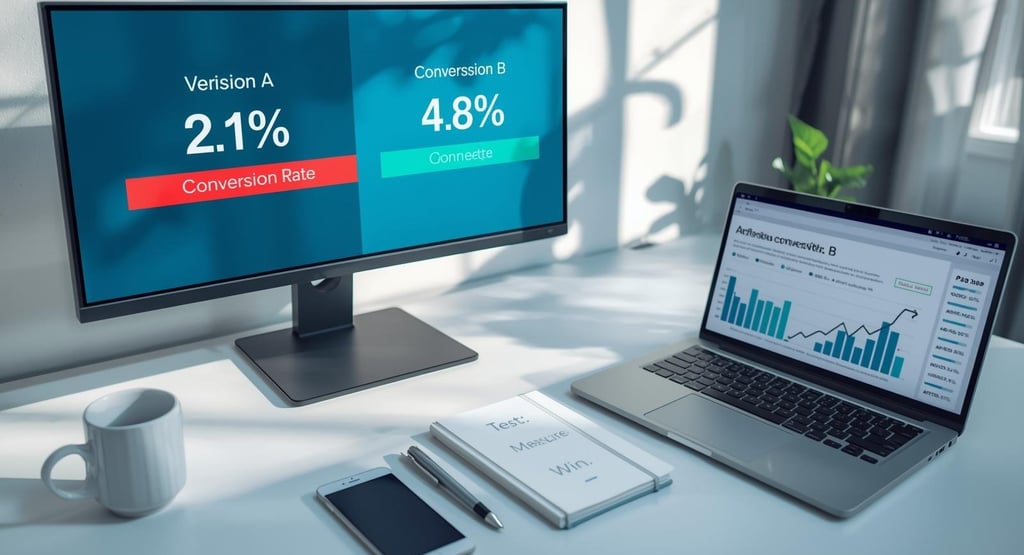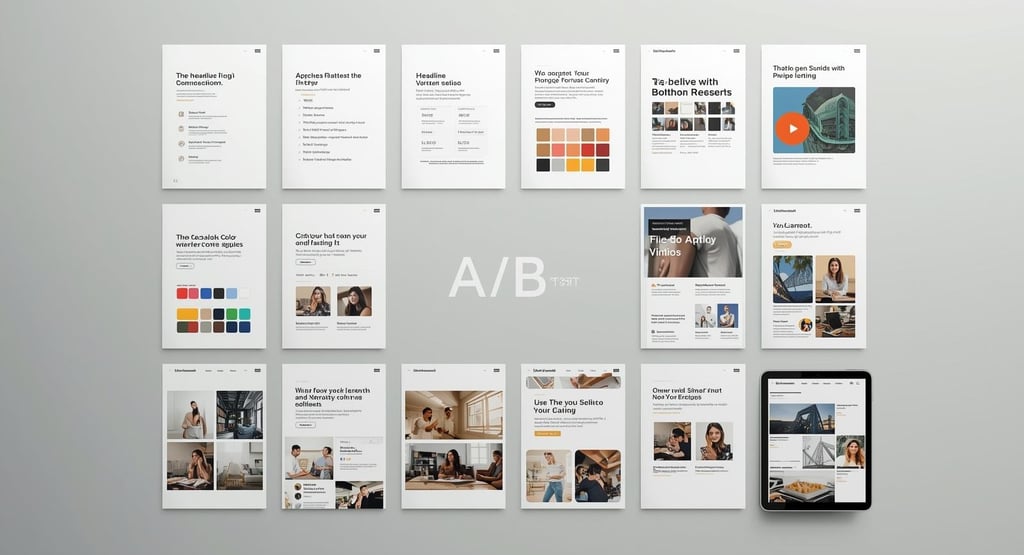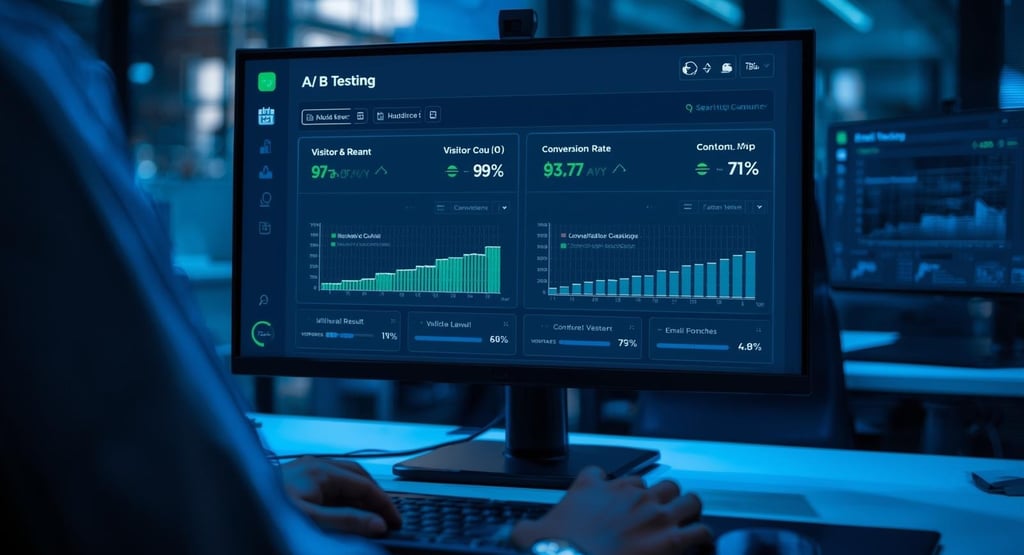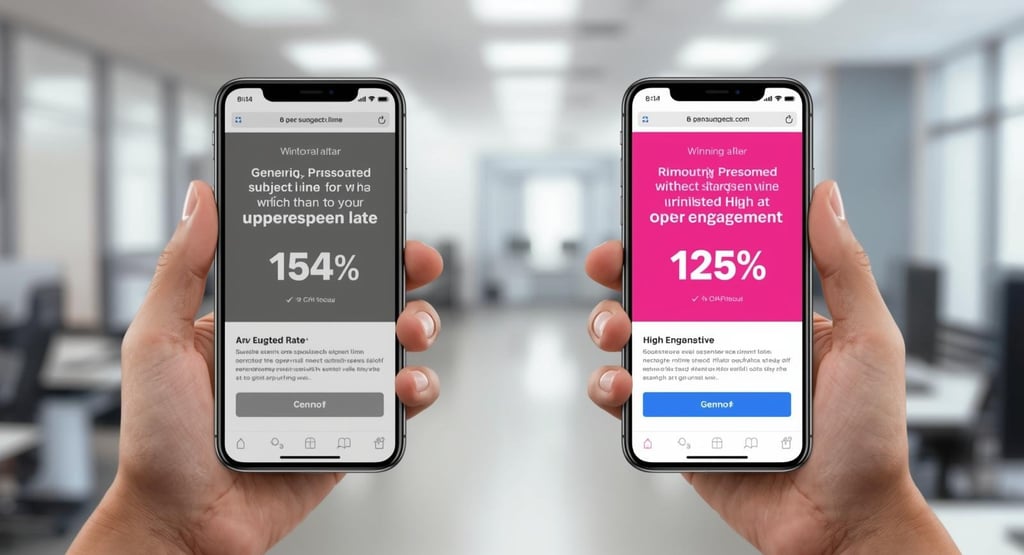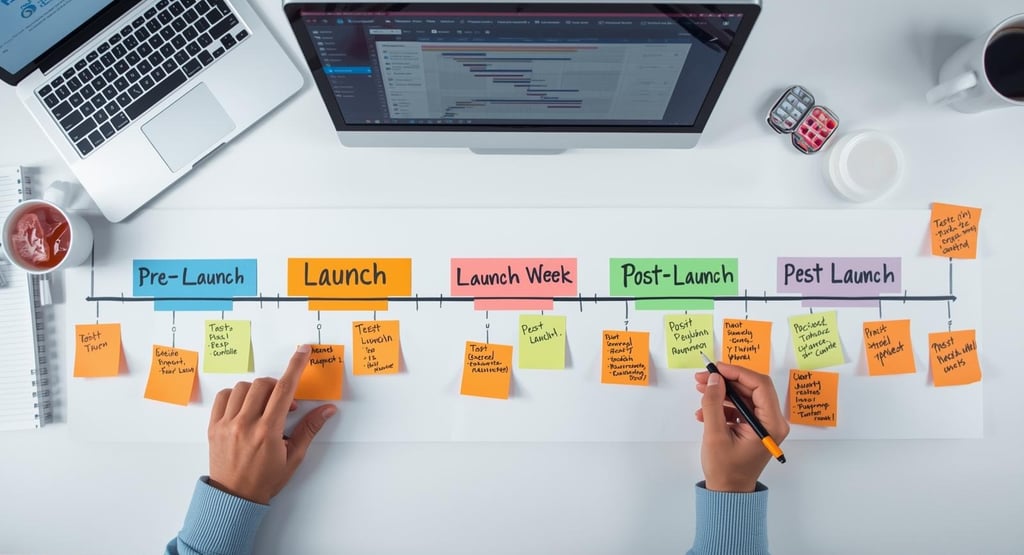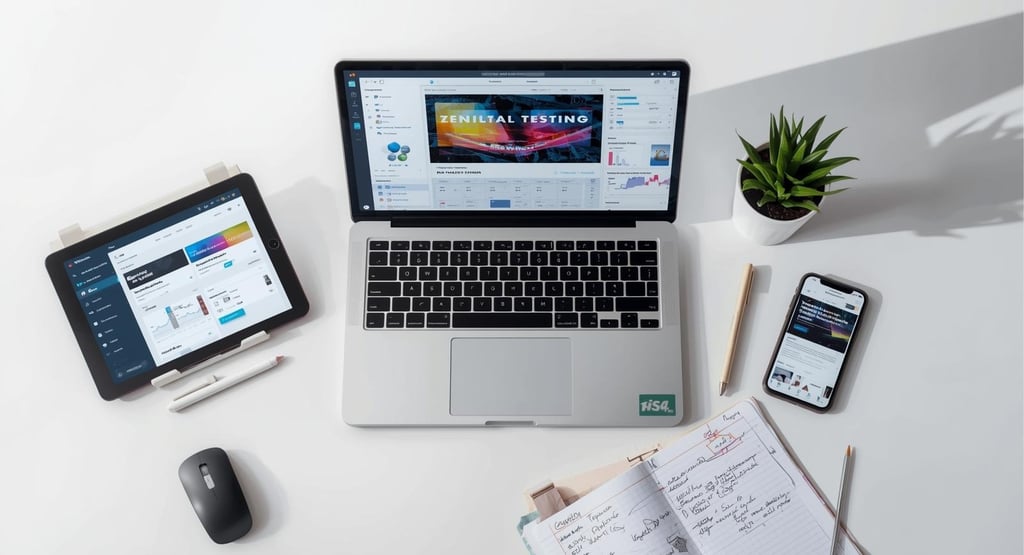Stop Scrolling, Start Creating ⚡ Visit Our Digital Store Now!
A/B Testing Your Product Launch Messaging: What to Test & How to Double Your Conversions
A/B testing your product launch messaging can double your conversion rates. Get proven strategies for testing headlines, CTAs, visuals, and pricing. Includes real examples, tools, and a complete testing roadmap for launches.
DIGITAL MARKETINGMAKE MONEY ONLINESOCIAL MEDIAE-COMMERCEAFFILIATE MARKETINGONLINE BUSINESS IDEAS
Eddy Enoma
11/3/202514 min read
The Data-Driven Approach to Finding Messages That Actually Convert
You launched your product. You followed the playbook. You built your email sequences. But your conversion rate is stuck at 2%, and you're watching potential customers slip away. You know something's not working, but you're guessing in the dark about what to fix.
Here's the reality: even the best marketers can't predict what messages will resonate with your specific audience. What works for one product crashes and burns for another. The difference between a launch that barely breaks even and one that generates serious revenue often comes down to a few words, a different headline, or a button color you never would have guessed mattered.
A/B testing your product launch messaging isn't about making random changes and hoping for the best. It's about systematically discovering what actually drives conversions with your audience. According to Invesp, companies that run consistent A/B tests see conversion rate improvements of 49% on average. That's not a small bump; that's the difference between struggling and scaling.
The good news? You don't need a massive budget or a data science degree to run tests that dramatically improve your results. What you need is a structured approach to testing, the right tools to measure what matters, and the discipline to let data guide your decisions instead of your gut feelings.
In my previous guides, I covered how to launch a product with real traction and how to turn signups into paying customers with email automation. This article picks up where those left off, showing you exactly how to optimize every message, every headline, and every call to action so your launch converts at the highest possible rate.
Why Most Founders Skip A/B Testing (And Why That's Costing Them)
Let's be honest. Most people skip testing because it feels like extra work. You've already written your landing page copy. You've crafted your emails. You've designed your signup flow. The idea of creating multiple versions and waiting for data feels like it's slowing you down when you just want to launch and move forward.
But here's what that mindset costs you. Let's say you're driving 1,000 visitors to your landing page and converting at 2%. That's 20 signups. If a simple headline test boosts your conversion to 3%, you just got 30 signups from the same traffic. That's 50% more leads without spending an extra dollar on ads or promotion.
Scale that over weeks and months, and the compounding effect is massive. The difference between a 2% conversion rate and a 5% conversion rate on 10,000 visitors is 300 signups versus 500 signups. That's not marginal, that's transformational for your business.
Research from Econsultancy shows that for every dollar spent on conversion rate optimization, companies see an average return of $22. Compare that to paid advertising, where you're often paying more for each incremental customer. Testing is one of the highest ROI activities you can invest time in.
Yet founders skip it because they think they need complex tools, big budgets, or statistical expertise. The truth is simpler. You need curiosity about what works, a willingness to be wrong about your assumptions, and basic tools that show you what's actually happening with real users.
Think about your launch this way: you're having a conversation with thousands of people simultaneously. A/B testing is how you learn which version of that conversation makes people lean in and take action, versus tune out and leave. Every test teaches you something about your audience that makes every future message better.
What Actually Matters: The Elements Worth Testing
Not everything deserves a test. Some elements have a massive impact on conversion rates, while others make almost no difference. Focus your energy on the high-impact areas first.
Headlines and Value Propositions
This is the single most important element to test. Your headline is the first thing people see, and it determines whether they keep reading or bounce. According to Copyblogger, 80% of people will read your headline, but only 20% will read the rest of your content.
Test different angles. Are you leading with the benefit, the problem you solve, or social proof? Are you asking a question or making a bold statement? A headline focused on "Save 10 Hours Per Week" might perform completely differently from "The Project Management Tool Built for Remote Teams."
Test specificity. "Increase Your Conversions" is vague. "Turn 2% of Your Traffic Into Paying Customers" is concrete. Specificity often wins because it creates a clearer picture in the reader's mind.
Test length. Sometimes shorter, punchy headlines work better. Other times, longer, more descriptive headlines outperform because they provide more context. You won't know until you test with your specific audience.
Call-to-Action (CTA) Copy and Design
Your CTA is where conversion happens or doesn't. Small changes here can create massive swings in results. Unbounce data shows that personalized CTAs perform 202% better than generic ones.
Test the actual words on your button. "Get Started" versus "Start Your Free Trial" versus "See How It Works" can all perform differently. Action-oriented language typically works well, but what resonates depends on your product and audience intent.
Test urgency and scarcity. Does adding "Limited Spots Available" or "Offer Ends Friday" increase conversions? Sometimes urgency works. Other times, it feels pushy and backfires. The only way to know is by testing.
Test button color and size. Yes, this matters more than you'd think. A study by HubSpot found that changing a button from green to red increased conversions by 21%. But that doesn't mean red always wins. Context matters. Test what stands out on your specific page design.
Test placement. Should your CTA be above the fold, in the middle of your content, or at the bottom after you've built your case? Test multiple placements or even multiple CTAs on the same page.
Visuals and Product Imagery
People process images 60,000 times faster than text, according to research from 3M Corporation. What you show matters as much as what you say.
Test hero images. Should you show your product interface, show people using your product, or use an abstract visual that represents the outcome? Different approaches resonate with different audiences.
Test video versus static images. Video can increase conversion rates by up to 86%, according to Eyeview. But only if the video is good and loads quickly. A poorly made video or one that slows down your page can hurt conversions.
Test social proof visuals. Showing faces of real customers, logos of companies using your product, or screenshots of testimonials can all impact trust and conversion differently.
Email Subject Lines and Preview Text
If you've built an email launch sequence, testing your subject lines is critical. Campaign Monitor reports that 47% of email recipients open emails based on the subject line alone.
Test curiosity versus clarity. "You're going to love this" creates curiosity. "Your free trial is ready" is clear and direct. Both approaches can work depending on your audience and where they are in the customer journey.
Test personalization. Including the recipient's name or company in the subject line can increase open rates by 26%, according to Experian. But overuse of personalization can feel creepy. Test what feels natural.
Test length. Short subject lines under 50 characters perform well on mobile. Longer subject lines can provide more context. Your audience and their device preferences will determine what works best.
Pricing Display and Offer Structure
How you present your pricing can dramatically affect conversion rates. Sometimes showing the price upfront builds trust. Other times, it creates sticker shock before you've built enough value.
Test showing pricing versus hiding it behind a demo request. For higher-ticket items, requiring a conversation might convert better. For low-friction products, transparent pricing often wins.
Test different pricing tiers. Offering three options instead of one can increase conversions through the anchoring effect, where the middle option looks more reasonable compared to expensive and cheap alternatives.
Test the monthly versus annual pricing display. Some audiences prefer seeing the lower monthly number. Others prefer the savings message of annual pricing. Test both presentations.
How to Set Up A/B Tests That Actually Teach You Something
Running random tests wastes time and teaches you nothing. Good testing requires structure and discipline.
Start With a Clear Hypothesis
Don't just change things randomly. Form a specific hypothesis about what you expect to happen and why. "I believe changing the headline from [X] to [Y] will increase conversions by at least 10% because [reason based on user feedback or data]."
This forces you to think critically about what you're testing and why it matters. It also helps you learn even when a test fails. If your hypothesis is "Users don't understand what our product does," and your clearer headline doesn't improve conversions, you've learned the problem isn't clarity but something else entirely.
Test One Variable at a Time
This is critical. If you change your headline AND your CTA AND your image all at once, and conversions go up, which change actually made the difference? You have no idea.
Test one element at a time so you know exactly what's driving results. Yes, this takes longer than changing everything at once. But it gives you learning you can apply to everything else you build.
The exception is when you want to test completely different approaches to your entire page. In that case, you're not testing individual elements but testing different strategic directions. That's valid, but know that's what you're doing.
Determine Your Sample Size and Test Duration
You can't call a test after 50 visitors. Statistical significance matters. Generally, you want at least 100 conversions per variation before concluding. That means if your conversion rate is 2%, you need at least 5,000 visitors per variation.
Run tests for at least one full week to account for day-of-week variations. Traffic on Monday might behave differently from traffic on Saturday. You want to capture a complete picture of how your audience behaves.
Use a significance calculator to determine when your results are reliable. Most A/B testing platforms have this built in. Don't call a winner prematurely. A result that looks like a 30% improvement with 200 visitors might regress to a 5% improvement with 2,000 visitors.
Use the Right Tools for Your Testing
You don't need enterprise software to run effective tests. Several tools make A/B testing accessible for launches and early-stage products.
For landing pages and website testing, platforms like A/B Testing AI help you set up experiments quickly and provide AI-powered insights about what's working and why. The platform analyzes your variations and suggests optimizations based on patterns it recognizes from millions of data points.
For email testing, your email platform should have built-in A/B testing. GetResponse includes A/B testing features that let you test subject lines, send times, and email content. You can automatically send the winning variation to the rest of your list.
For more complex testing across your entire funnel, Google Optimize integrates with Google Analytics and is free for basic use. It's powerful enough for most launches and early-stage optimization.
The tool matters less than your commitment to testing consistently and learning from results. Start with whatever's easiest to implement. You can always upgrade to more sophisticated tools as your needs grow.
Document Everything
Keep a testing log. What did you test? What was your hypothesis? What were the results? What did you learn? This becomes invaluable over time as patterns emerge about what works with your specific audience.
Your testing log also prevents you from testing the same thing twice or forgetting what you learned six months ago. Institutional knowledge compounds when you document it.
Real Examples: Tests That Made a Massive Difference
Let's look at specific examples of tests that dramatically improved conversion rates.
Example 1: Headline Test That Increased Signups by 38%
Original headline: "Project Management Made Simple" Winning variation: "See Everything Your Team is Working On in One Place"
Why it worked: The winning headline was more specific and painted a clearer picture of the actual benefit. "Made Simple" is vague. "See everything in one place" tells you exactly what you get.
Example 2: CTA Button Test That Boosted Conversions by 24%
Original CTA: "Sign Up" Winning variation: "Start My Free Trial"
Why it worked: The winning version was first-person ("My") and included the key benefit (free trial). It felt more personal and reminded users they weren't spending money.
Example 3: Pricing Page Test That Increased Purchases by 31%
Original approach: Three pricing tiers presented equally. Winning variation: Three tiers with the middle tier highlighted as "Most Popular"
Why it worked: The anchor effect. When one option is highlighted, people gravitate toward it. The middle tier felt like the safe, recommended choice.
Example 4: Email Subject Line Test That Doubled Open Rates
Original subject: "Introducing [Product Name]" Winning variation: "How [Customer Name] saved 12 hours last week"
Why it worked: The winning subject focused on a customer outcome instead of the company announcement. People care more about results than product names.
Example 5: Landing Page Image Test That Increased Conversions by 19%
Original image: Product screenshot Winning variation: Photo of person using the product with a smile
Why it worked: The human element created emotional connection. People saw themselves in the image, which made the product feel more relatable and desirable.
Common A/B Testing Mistakes That Waste Your Time
Even when people commit to testing, they often make mistakes that invalidate their results or lead to wrong conclusions.
Calling Tests Too Early
This is the biggest mistake. You see an early lead and declare a winner before you have statistical significance. Conversion rates fluctuate. Early results often don't hold as the sample size increases.
Wait until you hit your predetermined sample size and test duration. Patience in testing saves you from implementing changes that don't actually work.
Testing Too Many Things at Once
You change five elements, and conversions improve. Great! But which change made the difference? You don't know, so you can't replicate the learning elsewhere.
Test one variable at a time. Build your knowledge systematically. It's slower initially, but creates compounding learning over time.
Ignoring Context and Seasonality
You run a test during a holiday sale, and your urgent messaging wins. Then you implement that urgent tone permanently, and it stops working once the sale ends.
Consider external factors that might influence results. Is there a seasonal pattern? Did you just get featured somewhere that brought different traffic? Context matters when interpreting results.
Not Following Through on Learnings
You run a test, get clear results, then never implement the winner or apply the learning to other areas. Testing without action is pointless.
When you learn something works, roll it out everywhere it's relevant. If a specific value proposition wins on your landing page, test that same angle in your email sequences and ad copy.
Testing Superficial Elements Before Fundamental Ones
Don't test button colors before you've tested your value proposition. Start with the biggest levers first. Once you've optimized headlines, CTAs, and core messaging, then you can worry about visual tweaks.
Focus on elements that can move the needle by 20% or more before optimizing for 2% improvements.
Your A/B Testing Roadmap for Product Launches
Here's a practical timeline for testing throughout your launch process.
Pre-Launch (2-3 Weeks Before)
Test your landing page headline. This is your highest-impact test. Run at least two variations and drive traffic to see what resonates.
Test your email signup form. Should it be above the fold or below? Should you ask for just email or email plus name? Should you offer an incentive?
Test your initial email sequence subject lines. Before you blast your full list, test with a small segment to see which subjects generate the best open rates.
Launch Week
Test your launch announcement email subject line. Send to 20% of your list with two different subjects. Send the winner to the remaining 80%.
Test your pricing presentation. If you're showing prices, try different ways of displaying them. If you're not showing prices, test requiring contact versus immediate transparency.
Test your CTA copy on your main conversion page. Run at least two variations to find language that drives action.
Post-Launch (Ongoing)
Test your onboarding email sequence. What gets new users to activate faster? Test different sequences and measure activation rates.
Test different content formats for nurture. Do case studies convert better than how-to guides? Do videos outperform text? Let data guide your content strategy.
Test your referral messaging. What incentive structure gets people to actually share? Test different offers and see what drives the most referral traffic.
Continue testing systematically. Every month, run at least two tests on critical conversion points in your funnel. Small improvements compound over time.
The Metrics That Tell You If Your Tests Actually Matter
Running tests is useless if you're not measuring the right things. Here are the metrics that matter.
Conversion Rate
This is the primary metric for most tests. What percentage of people who see your variation take the desired action? Whether that's signing up, purchasing, or clicking through to the next step, conversion rate tells you if your change worked.
Statistical Significance
This tells you if your results are real or just a random chance. Most tools calculate this automatically. You want at least 95% confidence before declaring a winner. Anything less, and you might be seeing noise instead of signal.
Revenue Per Visitor (RPV)
Sometimes a variation increases conversions but decreases average order value. RPV captures the full picture. A 10% increase in conversions that drops your average purchase by 20% is a bad trade.
Time on Page and Bounce Rate
These secondary metrics help you understand user engagement. If a new headline increases conversions but also increases bounce rate, you might be attracting the wrong people or confusing visitors.
Segment Performance
Sometimes a change works great for one segment and terrible for another. Look at how different traffic sources, device types, or user behaviors respond to your variations. This gives you deeper insight than overall numbers alone.
Tools and Resources to Level Up Your Testing
Beyond what I've already mentioned, here are additional resources that can accelerate your testing program.
For Visual A/B Testing and Optimization
A/B Testing AI provides intelligent recommendations based on your test results and helps you identify what to test next. The platform learns from millions of experiments and applies those patterns to suggest optimizations specific to your funnel.
For Email Sequence Testing
GetResponse's automation features let you test entire email workflows, not just individual messages. You can create competing sequences and measure which path drives better activation, retention, and revenue.
For Capturing Test Traffic
Make sure you're capturing leads effectively with optimized forms and pop-ups. Your tests only work if you have enough traffic to reach statistical significance.
For Live Feedback and Iteration
Tidio's live chat lets you ask visitors in real time what's confusing or what stopped them from converting. This qualitative feedback helps you form better hypotheses for quantitative tests.
For Calculating Statistical Significance
Use free calculators from Optimizely or VWO to determine when you have enough data to call a test. Don't rely on gut feel. Let math tell you when results are reliable.
Your Next Steps: Start Testing This Week
You don't need to overhaul everything at once. Start small and build momentum.
Pick one high-impact element to test this week. Your landing page headline is usually the best starting point. Create two variations, split your traffic, and let it run for at least a week.
Document your hypothesis. Write down what you expect to happen and why. This keeps you honest and helps you learn even from failed tests.
Set up your testing tool. If you haven't already, implement A/B testing software on your key pages. Most platforms have free tiers that are perfect for getting started.
Commit to ongoing testing. Make it a habit to run at least one test every two weeks. Small improvements compound. A series of 10% improvements across different elements can double or triple your overall conversion rate.
Review your launch strategy and your email sequences through the lens of testing. What assumptions did you make that you haven't validated? Those are your next test opportunities.
A/B testing isn't glamorous. It's not the exciting part of launching. But it's the difference between launches that fizzle and launches that scale. When you let data guide your decisions instead of opinions, you stop guessing and start knowing what actually works with your audience.
That knowledge is what transforms good products into successful businesses. Start testing today, and watch your conversion rates climb week after week.
Don't lose this momentum. Small improvements compound into massive growth. Join the free newsletter for the data-driven insights and next-test ideas delivered to your inbox weekly. 👇
Subscribe for Exclusive Tips & Updates. Enter Your Email Below!



Get the latest strategies to create, automate, and monetize with AI, content, and digital marketing straight to your inbox!
🔒 We respect your privacy. Your email is safe with us. Unsubscribe anytime.
Address
Sporerweg 16
94234 Viechtach, Germany
Contacts Us
(049) 170 499 6273
Subscribe to our newsletter
© 2025 Onlinebizoffers. All rights reserved.

